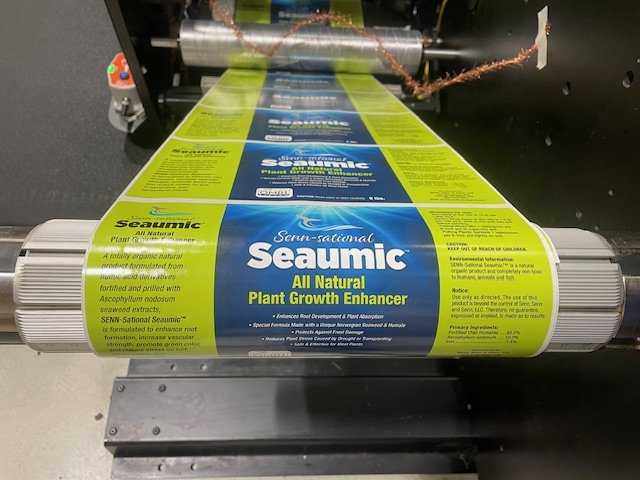Achieving impeccable results in labeling demands creativity, design finesse, and meticulous attention to the technical aspects of the printing process. Among the various printing methods, flexography, or flexo printing, stands out for its versatility and efficiency in producing high-quality labels. However, mastering the setup of a flexo press run is essential to harness the full potential of flexo printing
Flexography is a modern printing technique that utilizes flexible relief plates to transfer ink onto substrates, such as paper, film, or metallic foil. This method is favored for label printing and unsupported films because it can accommodate various materials and produce vibrant, durable, impactful prints. When running a flexo press, preparation is critical to ensure a successful outcome.
At Clemson University, one of my professors, Page Crouch, taught me a simple yet powerful statement that has stuck with me: “Design for success.” This statement holds a lot of significance, emphasizing the importance of careful planning and consideration in every step of the label process. It means that every decision, from the smallest details to the big picture, should be made with the ultimate goal of achieving success.
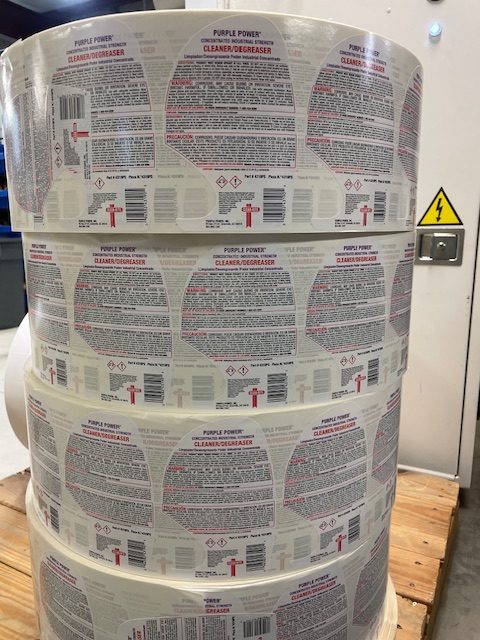 At every pre-press stage, optimization for the best outcome is key. Preparing the artwork starts with the label design for flexo printing. This involves carefully selecting appropriate colors, defining trapping and overprinting settings (which refer to the techniques used to prevent gaps or overlaps between adjacent colors in a print), using printable fonts and point size, and setting up dieline and bleed specifications. A dieline is a graphic element that serves as a template or guide to create a die, which is then used to cut or shape the label substrate.
At every pre-press stage, optimization for the best outcome is key. Preparing the artwork starts with the label design for flexo printing. This involves carefully selecting appropriate colors, defining trapping and overprinting settings (which refer to the techniques used to prevent gaps or overlaps between adjacent colors in a print), using printable fonts and point size, and setting up dieline and bleed specifications. A dieline is a graphic element that serves as a template or guide to create a die, which is then used to cut or shape the label substrate.
When preparing for the flexo printing process, creating high-quality flexographic plates is crucial to reproduce the design elements accurately. Laser engraving is commonly used to make these plates, as it can achieve curves and other specifications that result in precise and accurate prints on the press. This translates to a high-quality, impactful final print that meets the design and application requirements.
Consistency in color is also critical in flexo printing. Color management practices are implemented to achieve this, including calibrating color profiles and performing color proofs to verify color accuracy before printing. Ensuring the desired effect in the print is achieved when the ink hits the substrate results in consistent color across different printing runs.
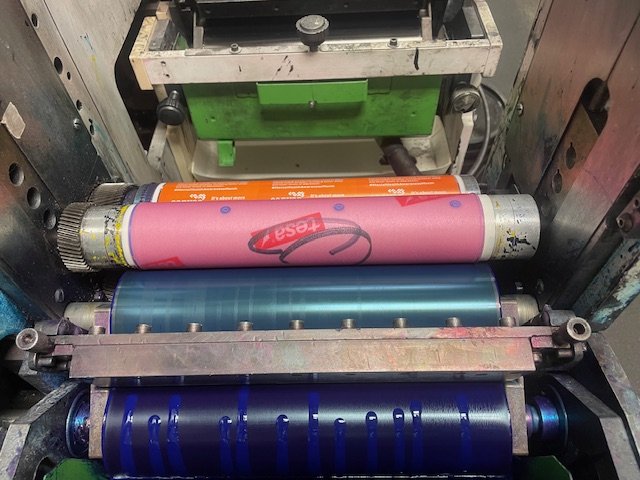 After the prepress steps have been performed, the next order of business is setting up the press. This stage involves choosing the appropriate label substrate based on the application requirements and selecting ink formulations compatible with the preferred substrate. These first steps ensure that the substrate is clean, free from dust or debris, and properly conditioned to minimize static electricity. Ink viscosity adjustments are also conducted to achieve optimal ink transfer and color density to meet desired color specifications.
After the prepress steps have been performed, the next order of business is setting up the press. This stage involves choosing the appropriate label substrate based on the application requirements and selecting ink formulations compatible with the preferred substrate. These first steps ensure that the substrate is clean, free from dust or debris, and properly conditioned to minimize static electricity. Ink viscosity adjustments are also conducted to achieve optimal ink transfer and color density to meet desired color specifications.
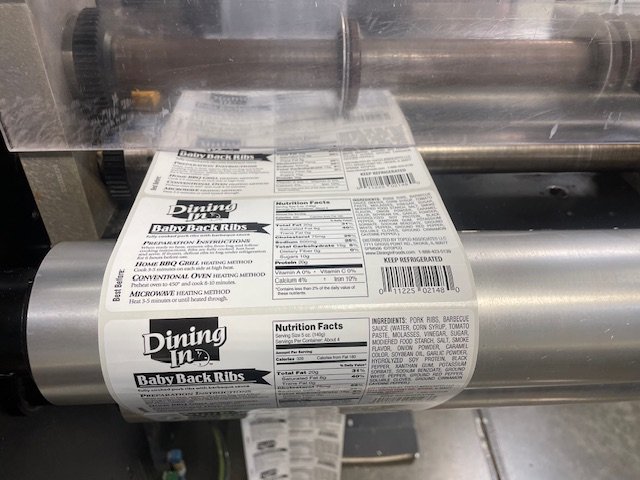 Next, the press setup agenda involves carefully mounting the flexographic plates onto the printing cylinders to ensure proper alignment with the cutting die. Once the plates are firmly secured using tapes or adhesive materials, it’s time to choose the appropriate anilox rolls based on the desired ink coverage and resolution requirements. Fine-tuning the printing pressure settings to achieve optimal contact between the plates, anilox rolls, and substrate is a prerequisite to avoiding excessive pressure, which can lead to plate distortion, wrong color, or substrate deformation.
Next, the press setup agenda involves carefully mounting the flexographic plates onto the printing cylinders to ensure proper alignment with the cutting die. Once the plates are firmly secured using tapes or adhesive materials, it’s time to choose the appropriate anilox rolls based on the desired ink coverage and resolution requirements. Fine-tuning the printing pressure settings to achieve optimal contact between the plates, anilox rolls, and substrate is a prerequisite to avoiding excessive pressure, which can lead to plate distortion, wrong color, or substrate deformation.
When printing labels with multiple colors, meticulous calibration of the registration settings is essential to maintain accurate alignment. This prevents design elements from shifting and compromising the final product’s quality. Regularly monitoring and adjustment of ink density levels ensure consistent color intensity and coverage. Quality inspections, including the use of cameras to zoom in and monitor print quality, are a must throughout the press setup process to identify misregistration, color variations, or print imperfections.
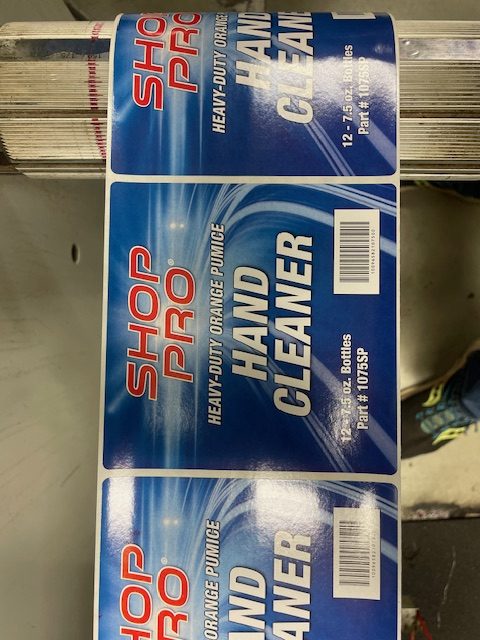 Post-press setup is just as important as the prepress and press setup stages. Regular maintenance tasks, such as cleaning ink chambers, doctor blades, and anilox rolls, prevent ink buildup and maintain printing consistency. Replacing worn-out or damaged components as needed is a proactive measure to avoid production disruptions. By performing these tasks regularly, you can keep your equipment in top shape, extend its lifespan, and maximize its performance for each label job.
Post-press setup is just as important as the prepress and press setup stages. Regular maintenance tasks, such as cleaning ink chambers, doctor blades, and anilox rolls, prevent ink buildup and maintain printing consistency. Replacing worn-out or damaged components as needed is a proactive measure to avoid production disruptions. By performing these tasks regularly, you can keep your equipment in top shape, extend its lifespan, and maximize its performance for each label job.
At Century Printing and Packaging, we believe in fostering a culture of continuous learning and knowledge sharing among our team. We understand the importance of mastering the art of flexo press setup for label printing, as it unlocks the full potential of flexography and enables us to deliver outstanding results that meet the highest standards of quality and efficiency. Our team is trained to focus on every aspect of flexo press setup, from selecting the proper plates and inks to ensuring optimal ink transfer, registration, and consistency. Our commitment to due diligence ensures we deliver exceptional results with every label job, from pre-press preparation to press setup procedures to post-setup optimization.

